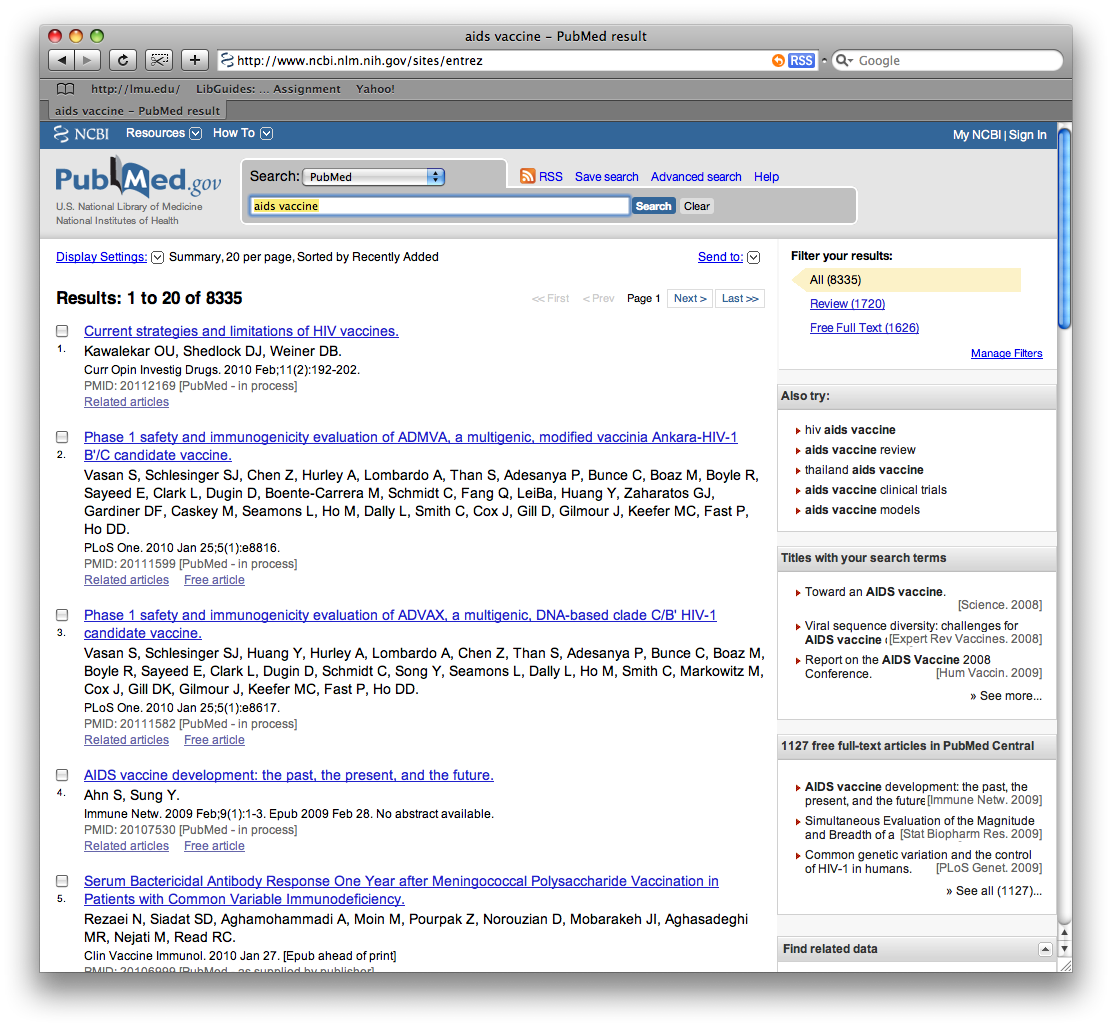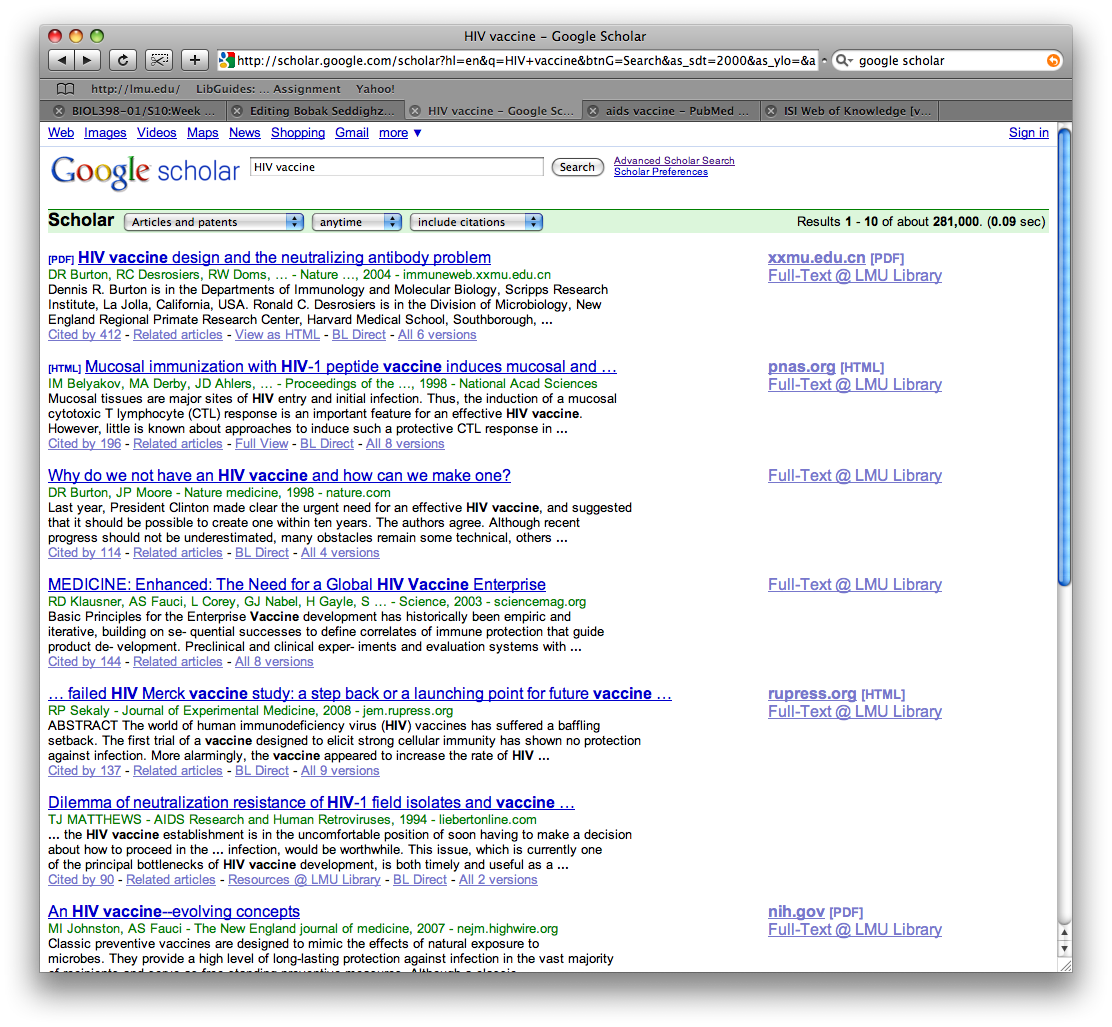Bobak Seddighzadeh Week 3
In class activity
What do I already know about HIV?
HIV stands for human immunodeficiency virus. I know that HIV is a retrovirus that affects immune cells, specifically T cells. Viruses are non-living and need a host cell to carry out its replication process because they do not synthesize their own proteins. Retroviruses contain reverse transcriptase which synthesizes a c-DNA template from RNA. HIV infects the host cell. It then injects its genome from its capsid and uses reverse transcriptase to create a c-DNA template that it then incorperates into the host cells DNA. It then uses the host cell's machinery to replicate itself.
Questions:
- Is it in the lytic or lysogenic life cycle?
- What makes HIV a more virulent virus in comparison to other viruses?
- Why do we not have a cure for HIV?
Finding a scholarly review:
I used three sources to find a scholarly review article on HIV vaccine: pubmed, google scholar, and ISI web of knowledge. Of the three I found pubmed ISI to be the most useful databases. I liked pubmed for several different reasons. Firstly, as you type in a topic in the search it begins to list the potential topics or searches that you may want. This helped me to delve into the topic of HIV vaccines. Also, pubmed gives me a host of useful windows on the right side of the screen to enhance my search if I am not satisfied with the current search. One of these windows on the right conveniently links you to another search page that has only review articles on your topic.
I also liked the search for ISI web of knowledge because on the left side of the screen there are many search refining options that are very straight forward and easy to use. In fact the way the site is structured is almost grounds for me to be more likely to use this website over pubmed depending on what articles I get from the two searches.
The reason I did not like google scholar as much was for the fact that it did not seem to have as many search and filter options.
With respect to the search options, I got different articles for each of the general searches for HIV vaccine and I probably would not notice matches unless I refined my search even further.
Journal Club:
- What is the main result presented in this paper? Fifteen subjects were analyzed for HIV-1 evolution from seroconversion at frequent intervals up to four years. The researchers found different patterns of selection were observed amongst non-progressor, moderate, or rapidly progressing subjects. They essentially found that both diversity and divergence per year increased in all three categories. The increase in diversity and divergence per year was much greater in non-progressors to moderate progressors to the rapid progressors. Increased diversity and divergence was associated with greater decline in CD4 T cell count.
- What is the importance or significance of this work? AIDs affects many people and people can die from AIDs especially when it turns into HIV. By studying the evolution of the different clones, it can provide insight potential patterns. This can provide essential information for drug development and treatment.
- What were the limitations in previous studies that led them to perform this work? Previous studies had very small pools of people and they were not able to get consistent cooperation for long periods of time. Furthermore, the sequences were not measured. In this study, they had more subjects over a longer period of time and sequenced the events.
- What were the methods used in the study? Obtained blood in six-month intervals from 15 participants selected from ALIVE study. Nested PCR was used to help Sequence of HIV-1 env genes. Reverse transcription-PCR was sued to determine the plasma viral load. Mega computer package was used to construct phylogenetic trees.
- Briefly state the result shown in each of the figures and tables. Figure 1 shows the CD4 T cell counts, diversity, and divergence of the fifteen different subjects. They were classified into Rapid progressors, moderate progressors, and non-progressors. Table 1 shows the CD4 cell count and the annual rate of CD4 T cell decline in relation to the number clones, and slope of divergence and diversity. Figure 2 shows the slopes of diversity and divergence in different progressor groups. Groups classified as rapid progressors had the highest rate of change in both graphs and non-progressors exhibited the smallest slope in both graphs. Figure 3 is a phylogenetic tree from subject 9. It reveals that there was no one dominant strain throughout the year. Figure 4 shows the phylogenetic tree of four random subjects. Reiterates that evolution is not sustained along a single branch.
- How do the results of this study compare to the results of previous studies (See Discussion). Two different studies shows conflicting results. McDonald had similar results to Markham in that rapid progressors had more genetic divergence. However in the second visit, McDonald’s intravisit diversity for the rapid progressors was less than the slow progressors. In the second study, Wolinsky et al. (22) observed less genetic diversity in two subjects that had rapidly decline CD4 T cell count compared to slower declining CD4 T cell counts.
Ten Definitions:
- Seroconverting: The development of detectable specific antibodies to microorganisms in the blood serum as a result of infection or immunization.
- Coreceptors: a cell surface receptor that binds a signaling molecule in addition to a primary receptor in order to facilitate ligand recognition and initiate a biological process, such as entry of a pathogen into a host cell.
- Cohorts: A group of subjects who have shared a particular experience during a particular time span
- Mononuclear: Having only one nucleus; used especially in reference to blood cells. #Restriction sites: The site in a polynucleotide chain as to where the restriction enzyme cleaves nucleotides by hydrolyzing the phosphodiester bond between them.
- Recombinant DNA: Spliced dNA formed from two or more different sources that have been cleaved by restriction enzymes and joined by ligases. Genetically engineered dna made by recombining fragments of dna from different organisms
- Nonsynonymous mutation: A form of point mutation resulting in a codon that codes for a different amino acid, and thus, causes the synthesis of a protein with an altered amino acid sequence during translation
- Synonymous mutation: A type of point mutation in which a single nucleotide is substituted with (or exchanged for) a different nucleotide that may result in an altered sequence of amino acid during translation, which may render the newly synthesized protein ineffective
- CD4 T cells: A form of T lymphocyte with CD4 receptor on the cell surface that recognizes antigens of a virus-infected cell
- Variant: something which differs in form from another thing, though really the same.
- divergence: A moving or spreading apart or in different directions
- Electronic Journal
- Bobak Seddighzadeh Week 2
- Bobak Seddighzadeh Week 3
- Bobak Seddighzadeh Week 4
- Bobak Seddighzadeh Week 5
- Bobak Seddighzadeh Week 6
- Bobak Seddighzadeh Week 7
- Bobak Seddighzadeh Week 8
- Bobak Seddighzadeh Week 9
- Bobak Seddighzadeh Week 10
- Bobak Seddighzadeh Week 11
- Bobak Seddighzadeh Week 12
- Bobak Seddighzadeh Week 13
- Shared Journal
- BIOL398-01/S10:Class Journal Week 2
- BIOL398-01/S10:Class Journal Week 3
- BIOL398-01/S10:Class Journal Week 4
- BIOL398-01/S10:Class Journal Week 5
- BIOL398-01/S10:Class Journal Week 6
- BIOL398-01/S10:Class Journal Week 7
- BIOL398-01/S10:Class Journal Week 8
- BIOL398-01/S10:Class Journal Week 9
- BIOL398-01/S10:Class Journal Week 10
- BIOL398-01/S10:Class Journal Week 11
- BIOL398-01/S10:Class Journal Week 12
- BIOL398-01/S10:Class Journal Week 13
- Assignments
- BIOL398-01/S10:Week 2
- BIOL398-01/S10:Week 3
- BIOL398-01/S10:Week 4
- BIOL398-01/S10:Week 5
- BIOL398-01/S10:Week 6
- BIOL398-01/S10:Week 7
- BIOL398-01/S10:Week 8
- BIOL398-01/S10:Week 9
- BIOL398-01/S10:Week 10
- BIOL398-01/S10:Week 11
- BIOL398-01/S10:Week 12
- BIOL398-01/S10:Week 13
References
<biblio>
- Paper1 pmid=18833271
- Paper2 pmid=20112169


